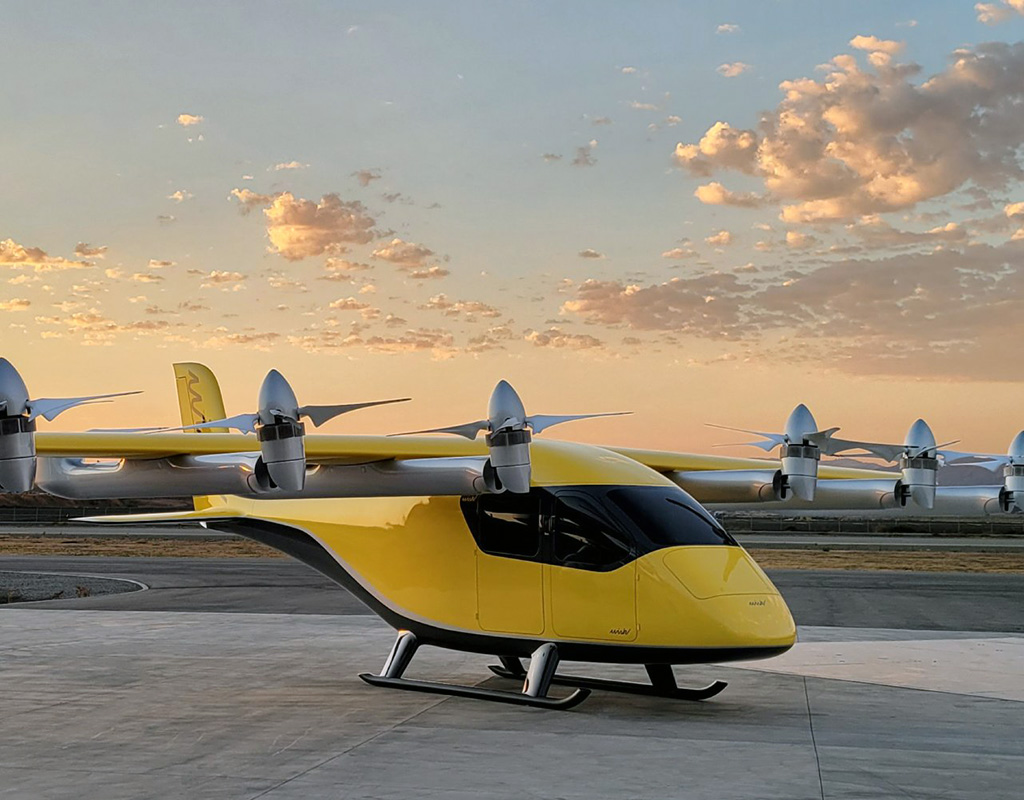
For California eVTOL startup Wisk Aero, autonomy has always been the key to unlocking scale in the advanced air mobility (AAM) industry.
“That’s why we think our work is important — not only for our success, but for the industry as a whole,” said Jonathan Lovegren, head of autonomy at Wisk.
The California startup inched one step closer to seeing its work become a reality by unveiling its sixth-generation eVTOL aircraft on Oct. 3 — this is the model it intends to get type certified with the U.S. Federal Aviation Administration (FAA) as an autonomous air taxi.
“We’re introducing the most technically advanced aircraft system in this marketplace,” Gary Gysin, president and CEO at Wisk, told media and guests who were invited to view the aircraft in person at the company’s flight test center in Hollister, California. “It’s self-flying, it’s all-electric, it’s four-passenger. We think this is going to change transportation.”
Up until this point, Wisk had only provided a small glimpse into its sixth-generation aircraft during a 60 Minutes segment with American broadcast journalist Anderson Cooper in the spring, opting instead to keep its eVTOL program under wraps.
The company has now unveiled the curtains on its newest aircraft mock-up. Donning the classic Wisk yellow that its predecessor Cora aircraft had been known for, Wisk’s sixth-generation vehicle is targeting a cruising speed of 120 knots (222 kilometers per hour or 138 miles per hour), and a range of 90 miles (144 kilometers) with reserves.

Wisk claims its proprietary 12-propeller design and boom configuration is equipped with improved propulsion systems, including tilting propulsion units in front of the wing and fixed lift units aft of the wing that are optimized for range. To reduce both in-cabin noise and the aircraft’s noise footprint, the aircraft’s propeller blades have increased in size and number.
With a simplified design, fewer moving parts, fully redundant systems, and no single point of failure, Wisk is aiming for the highest safety standards in commercial aviation.
“There is less than a billion chance that our system will fail,” said Sebastien Vigneron, senior vice president of engineering and programs at Wisk. “Those are simply the most stringent safety standards of today’s commercial aviation, and we’re going for that.”
While the aircraft will be designed for autonomous flights, humans will not be removed from the operations entirely. Every flight will be monitored by a supervisor who can intervene at any point.

“What’s particularly impressive is what you don’t see,” Gysin said. “There’s no pilot in the cockpit. There are no controls in the cockpit. You don’t see the autonomy system that we built and have been spending years curating. You don’t see the passenger research that’s gone into this, but you’ll see it by the comfort and how it feels.”
In designing its sixth-generation aircraft, Wisk said it has surveyed more than 630 people to ensure customer comfort, accessibility and inclusivity. Wisk said its aircraft includes a number of accessibility features, such as an entry and exit designed for people across the mobility spectrum, and user interfaces that accommodate people with hearing, vision and other impairments.
“We came to realize that the value of generation six goes far beyond just saving time by flying over the traffic,” said Uri Tzarnotzky, director of product design at Wisk. “Our passengers want to make the most of that time, either by being productive, or by being able to rest, relax and recharge. We’re working tirelessly to ensure that the aircraft and the ecosystem of products and services that support it are as accessible, inclusive and useful as possible.”
While the company has flown subscale models of its sixth-generation aircraft, it has yet to fly a full-scale version, and company executives were tight-lipped on when its flight test campaign would begin.

“We have the benefit of being private, so we don’t have to put milestones out there,” Gysin said. “We’re very happy with the milestones that we’re hitting but we don’t ever throw out dates, like when our entry into services is going to be, or when our first flight is. When we do it, we will announce it.”
Formed as a joint venture between Boeing and Kitty Hawk, Wisk has about 12 years of experience developing aircraft and more than 1,600 test flights under its belt. The startup had initially been tasked with carrying on the development of Kitty Hawk’s two-seat Cora aircraft, which Wisk will continue to use for flight testing and public events.
Wisk remains firm on type certifying and bringing its autonomous air taxi to market despite Kitty Hawk’s recent announcement that it would setting aside its single-seat Heaviside eVTOL program and winding down its operations.
Leaning on its strategic partnership with Boeing, Wisk has access to the aerospace company’s expertise in aircraft development, scale manufacturing, and certification. The startup also expects to tap into Boeing’s eVTOL and autonomy engineering resources to help advance its eVTOL program.


